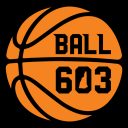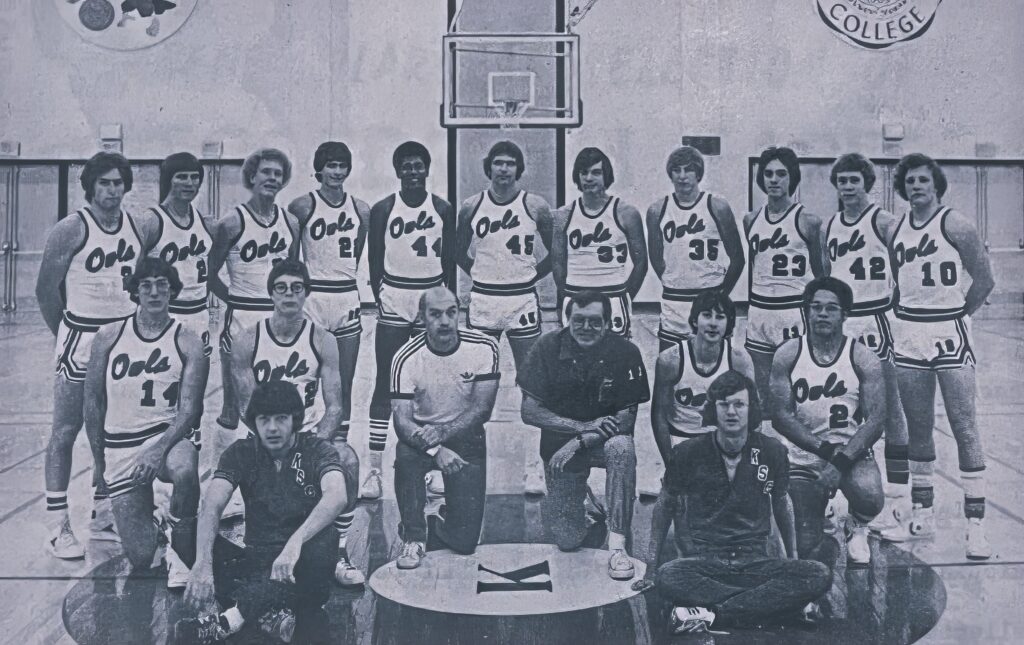(This is an excerpt – Chapter 16 – from Mike Whaley’s new college basketball book “Floor Burns.” It details the versatile college athletic life of former Alvirne HS star Paul Trocki, who played three sports at a high level at Keene State College – soccer, basketball, and track and field. Whaley’s sprawling celebration of NAIA basketball in New England encompasses 48 chapters and 620 pages. It is available for purchase through shopball603.com or bondcliffbooks.com. Retail options are listed below.)
Soccer provided the bookends for Paul Trocki’s Keene State College athletic experience in 1975 and 1979. Neither season, however, was as memorable as what went on in between.
One thing I found in writing this book is that many of the basketball players I interviewed played more than one sport, particularly those who played before 2000. Porky Vieira played baseball as did Ron Diorio and my friend and teammate Bill Fitzgerald; John Pazdar was a tennis player; Maureen Burchill and Terri Nelson played softball; Steve deBree was a soccer goalie; and Michelle DuFour Brodt picked up lacrosse and soccer when Castleton didn’t offer volleyball and track and field. Those are just examples. It’s a pretty lengthy list.
Paul Trocki’s multi-sport resume is the most impressive. The Pelham, New Hampshire native played three sports at Keene State. He was a key part of district champion basketball (1977) and soccer (1978) teams that qualified for the NAIA national tournament, while also competing in track and field. In 1979, Trocki won the NCAA Division III national championship in the decathlon. He was an All-American in soccer and track and field (twice). That’s a pretty impressive record for a guy who did not play organized sports until he was 13, and that was baseball, which he later dropped for track.
GROWING UP WITH BREAD
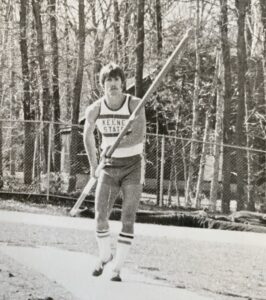
“I grew up in a bakery,” said Paul when I talked with him over the phone in September of ‘23 from his home in Leesburg, Florida, where he lives with Kelly, his wife of 35 years. “My dad (Stan Trocki) owned a bakery when I was 10 years old in Nashua (Debbie Lee Bakery, named after Stan’s first granddaughter). I got up and went in early in the morning with him.”
Paul did a lot of the grunt work, cleaning, washing pots and pans. But his dad did not like to decorate cakes, so that duty fell into Paul’s hands. On Saturdays, Paul would go into the Bakery with his dad at 3 a.m. Stan would start mixing bread doughs and then when it was done, let it sit and rise. “I would sleep on the flour sacks for a couple hours and then he’d wake me up when he needed a hand cutting the bread or working the oven,” Paul said.
Because he was always working, Paul’s first organized sport was Babe Ruth Baseball at age 13. “I couldn’t play Little League. I was working in my dad’s bakery.”
When Paul was at the bakery by himself, there was a big wall out back. He painted a strike zone on the side of the wall. He had a rubber-coated baseball, which he threw off the wall. He had his glove and he pretended he was playing shortstop fielding ground balls.
Paul also recalls in 1967 entering the Punt, Pass and Kick competition, which was sponsored by the National Football League and Ford Motor Company. He was 10. He recalls competing at historic Holman Stadium in Nashua, placing second in his age division with no football experience.
Paul was interested in playing football, but his mom, Celia Trocki, quickly snuffed out those hopes. She had two brothers who were seriously injured playing the sport, so she made it quite clear that Paul was not going to participate in football.
One day, Paul, then 13, decided to go to Babe Ruth tryouts. He showed up and the coaches were like “Who the hell is this kid?” He was picked to a team and ended up being selected to all-stars. “I always wanted to play sports,” he said. “I could never do it because I was working.”
Eventually he found his niche sports, which were track and field in the spring, basketball in the winter, and soccer in the fall. His high school PE teacher Donald “Ducky” Mead recognized Paul’s soccer potential watching him play crab soccer as a freshman. Paul was an excellent three-sport athlete at Alvirne. He was on playoff basketball teams, competed well in baseball and then track and field, and within two years of picking up the sport was an all-state goalie on outstanding Alvirne soccer teams, which also featured future Keene State basketball teammate, Kevin Savage. As a junior, the team won the state championship and then went on to win the New England title.
A minor wrench was thrown into Paul’s high school experience in 1974 when his hometown of Pelham opened its own high school. Having spent three years at Alvirne, he wanted to finish his senior year there. There was some question if that was possible, but eventually it worked out that he could. “I don’t know the politics behind it, but they allowed me to stay at Alvirne,” he said.
Here’s an amusing tidbit mentioned by Savage. After Alvirne won the New England soccer title, a group of players, minus Savage and Trocki, gathered at the school and with 10 gallons of paint brushed a huge white number one on the side of the brick building to celebrate their championship. When the principal saw it, he called in Savage, one of the captains, who explained he had nothing to do with it. Nonetheless he was told to get players together to scrub off the number with Brillo pads. They spent hours doing so, but could never quite remove it as some of the paint had already absorbed into the brick. The following year, the school burnt down, except for one wall. Yes, you guessed it, the wall with the faded number one stayed up. Over 50 years later, if you look closely at that wall, which was merged into the new building, you can still see the vague white outline of that number. In the trophy case, according to Savage, there is also a burnt soccer ball recovered from the fire with legible signatures of every player who played on that 1973 championship team.
Paul was not involved in the painting incident, but he definitely recalls it. “One of the guys went to his dad at 9:30 at night: ‘Dad, do we have a step ladder?’” Paul said. “He went and got a step ladder. When we came into school (on Monday) there were number ones everywhere. They were on the trash bins, side of the school. They were everywhere. … There were four of them that did it. I was not involved with that. I plead the fifth.”
HEADED FOR KEENE STATE
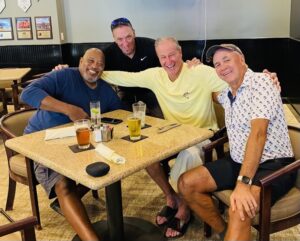
Paul’s initial plan when he graduated from high school was to buy a bakery. His dad nixed that, telling h2im he was going to college. He had interest from Keene State College soccer coach Ron Butcher, so he went to Keene to play soccer. The plan was pretty simple. He’d go to school, play soccer in the fall and compete with the track and field team in the spring. Basketball was not on his college radar. That plan changed.
As noted, Keene already had an All-American soccer goalie in sophomore Tad DeLorm, so Paul found himself in a back-up role as a freshman. One of his friends at Keene was Mike Theulen, who he had played basketball against in high school. Mike was also the son of Keene State basketball coach Glenn Theulen. Mike was constantly asking Paul to go out for basketball. He spurned those requests for a while, but then he realized that he was going to be sitting on the bench for three years as DeLorm’s understudy. Finally he went to Butcher and said he was done and that he was going to play basketball. Butcher was a little upset, but Paul thinks he understood the reasoning.
Of course, now that he’d chosen to switch sports, Paul wasn’t sure where he would fit in with the basketball team or if he would at all. “I had no idea,” he said. The thing was, the hoop team was pretty good. The Owls had gone to the NAIA national tournament in 1973 and 1974. The 21975-76 team was possibly the program’s most talented, going 17-12 and losing in the regional semis. There were no guarantees he was going to play.
8
“I was a decent athlete in all sports,” Paul said. “But I loved basketball the most. Mike (Theulen) knew me. He said I’d be fine. His dad must have heard.” Still Paul had his doubts.
“I thought I was in over my head,” he recalled. “This is a decent team. These are good guys. Maybe I shouldn’t be out there. But as I was practicing, I noticed I was bringing something to the team.”
It took a little while, but eventually Paul did find how he fit in. He was a 6-2 guard/forward type who could jump really well, even dunk the ball. He was fast so he could run the floor; he had the ability to make short jumper shots, and he could hit the offensive glass effectively. He was a perfect person to come off the bench to give the Owls some spark. He became the sixth man. “I didn’t realize it at the time, but I had my role,” he said. “I was part of the team.”
Paul had a connection on the court with star center Joe Yaris. “He’d grab a rebound and I’d break to the other end and he’d throw it to the foul line and I’d lay it in,” Paul recalled. “I got a lot of points that way, a lot of fast break points. I figured I could fit in.”
Yaris remembers that connection well. “I would just grab it and fling it to Trocki because I knew he could pretty much outrun anybody,” the center said.
In that sixth-man role, Paul averaged 8.3 points per game. He had some big games during the regular season in wins over Plymouth State (14 points), New Hampshire College (17) and Salem State (18). In the district championship, he scored 13 points to help beat two-time defending champion Husson, 85-76, notched 14 in the NESCAC championship win over Plymouth, and was the team’s high scorer with 17 points at the NAIA nationals when the Owls lost to Central Washington, 72-56, in Kansas City.
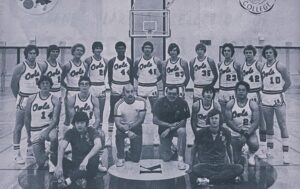
Mike Theulen was in awe of Paul’s high level of athletic versatility. “Had recruiting been as refined as it is now, he obviously would have been a Division I track scholarship guy.” As a basketball player, Mike recalled that Paul was an outstanding defender who could rebound and jump. “He could dunk. He had an excellent mid-range jump shot. He was a tough kid. We didn’t play much beyond six guys that year. Not much was expected that year. But we banded together so tightly. It was amazing. It was like Hoosiers. He was a big part of that.”
The following year with three key seniors graduated, Keene struggled, going 6-22. Paul led the team in scoring, but he didn’t enjoy himself. “There’s something wrong with the team if I’m the leading scorer,” he said.
Paul made the decision to return to soccer. He went to coach Theulen’s office to tell him of his decision. It did not go well. “He was really upset,” Paul recalled. “He looked at me and said, ‘Paul, if I were you I’d leave here, transfer. You’re not going to be anything.’ He was pissed. Mike and I stopped talking.”
He admitted that the Theulens’ negative energy “lit a fire under me a little bit.” He went on to become an All-American in both soccer and track and field.
It took some time, but Paul eventually mended fences with the Theulens. When Glenn was inducted into the Keene State Sports Hall of Fame in 2005, Trocki went to the ceremony. “We made up. We were fine,” he said.
As for Mike Theulen, they both moved on after Keene and did not stay in touch. The 1977 championship squad had a reunion in 2019 at Mike’s place in Myrtle Beach, South Carolina. The two made up and have stayed in touch since.
BACK TO SOCCER
In the fall of ‘78, Paul was returning to soccer after two seasons away from the sport. DeLorm, the All-American, was gone. “I was decent,” Paul recalled. “I knew I could beat them (other goalies) out and I did. It all worked out for me.”
Paul was more than decent. He led the Owls back to the NAIA national tournament in 1978 with a record of 15-5-3. He was named second team All-American. Keene went 1-2 at the nationals. They lost their first two games to eventual champions Quincy (Ill.), 3-1, and The King’s (N.Y.), 2-1, before winning their final game over Tennessee Wesleyan, 4-0. Paul ended the season with a record of 14-4-3 with a 0.88 goals against average (GAA) and nine shutouts.
The following year in 1979, Keene went 13-3-2, but did not make the tournament. Paul allowed nine goals with 98 saves for a .916 save percentage. Over 40 years later, he is still the program leader in career save percentage (.901) and GAA (0.74).
A PASSION FOR TRACK AND FIELD
While his soccer and basketball careers at Keene were patchwork, spring track and field proved to be the one constant. He competed all four years from 1976 to 1979.
Paul played baseball during the spring at Alvirne, but w8hen the school added track and field during his senior year, he jumped at the chance to unleash a hidden passion and join the inaugural team. “I took a lot of crap when I did that, but I could run well,” he said. He also had a minor track background as a youngster. “In first or second grade they had an event in Pelham called the Sport-O-Rama for kids,” Paul said. “It was a 50-yard dash, broad jump and something else. I think it was three events. Three years in a row I won three things. So I had these little trophies for three years in a row. I could never run track and field because it was never really around.”
Despite little experience, he did well in the 400-meter run and high jump, advancing to the New Englands in the 400.
Keene had a track team, but it didn’t have a track. The coach was Bob Taft, who was also the school’s financial aid director. “I hooked up with some crazy guys on the track team,” Paul said. “All fast.”
Paul picked up the decathlon, an event he had done once in high school, and really focused on it as a junior. He worked out at nearby Monadnock Regional High School. “They had a track I could run on, so I did that,” he said. “I could run fast and jump high. I couldn’t throw worth crap.” The decathlon is a grueling two-day competition comprising 10 events – 100-meter dash, long jump, shot put, high jump, 400, 110 hurdles, discus, pole vault, javelin, 1,500.
Paul knew he didn’t have the size to throw the shot put or the discus, but he could make up for those deficiencies in the runs. The pole vault was a challenge. “I practiced it and I couldn’t do it and couldn’t do it. But I did figure it out,” he recalled.
The decathlon is pretty simple in its concept, according to Paul. “The better you do, the more points you get. You try to get all PRs (personal records) in each event.”
One person who supplied Paul with a ton of advice was Keene State chemistry professor Jerry Jasinski, who died in 2021. He had a pretty impressive track-and-field background, including decathlon expertise, so that drew him to help Paul. Jasinski had an in at Dartmouth College in Hanover, N.H., occasionally taking Trocki up there to work out on his long jump and throwing events. “He gave me pointers along the way. He followed me pretty well,” Paul said. “I relied on Jerry to help out with stuff. He was a good old guy who if I had any questions he would help me. My weak events were the weight events – the discus and the shot. He helped me there.” Today Jasinski would likely be called a part-time volunteer assistant coach or consultant.
As a junior, Paul qualified in the decathlon for the NCAA Division III nationals at Calvin College in Grand Rapids, Michigan. Entering the final event (1,500), Trocki was near the bottom, 11th out of 16 competitors. There were two heats, and he was in the slower heat of eight runners because he was in 11th. “I could see who was ahead of me,” he said. “I’ve got to beat all those guys by a lot.”
Paul mentioned PRs, well he went out and ran one. He won the heat in 4 minutes, 11.4 seconds. “I almost lapped the last guy. I beat everybody there,” he said. After the second heat was run, Paul had tied for fifth, earning All-American honors as the top six received that accolade. “It kind of made me good for the following year,” he said.
In ‘79, Paul qualified again for the championships, this time as one of the favorites to win the decathlon. The national meet was held at Baldwin Wallace College in Berea, Ohio. Slippery Rock College from Pennsylvania won the team title, but they were also known for doing well in the decathlon. Paul recalls they had three competitors in that event. “They would keep coming over and talking to me to get in my head,” he said. “That went back and forth, but I was having a decent meet.”
After the first day, he was in second place thanks to strong finishes in the 400 (second) and the 100 (third).
On the final day, he stayed near the top. Paul got a PR in the pole vault, going a foot better than his previous best. The javelin was the second-to-last event. “I remember my best throw was around 180 feet,” Trocki said. “I threw it 205 feet, a really good throw.” He credits Jasinski with helping him to find a way to uncork that record throw.
That put him comfortably in first place with one event to go – the 1,500. “I was sitting there after the jav and going ‘shit, I’ve got this.’ Unless I fell during the 1,500, I wasn’t going to lose.”
“It’s funny how it happens,” Paul said. “The mind was there. They’re called PRs. I had PRs that day in the pole vault and the javelin. I had two PRs in the last three events. You score a lot of points if you do that. Some events you could score more. The vault was one if you could vault higher, there were more points available to get. In the 1,500, I knew I could hold my own there. I just needed to run well.”
Paul left nothing to chance in the fast heat of the 1,500. He won the race in 4:16 to cap off his championship performance with 7,163 points, finishing ahead of two Slippery Rock guys in second and third. He was selected as an All-American for the second consecutive year.
Because Paul was essentially working out on his own as a senior, the school required that he have someone to oversee those workouts and travel with Paul. That coach was Dave Terry (1969-71), one of Keene’s first basketball stars under coach Theulen. “He didn’t know anything about track, but we got along,” Paul said. “He was a supporter and all that.” While Terry could offer little in the way of decathlon instruction, as Jasinski could, he did help with the mental aspect because as a former basketball player he understood how that facet of sports worked. Mostly, however, he stayed out of the way and let Paul do his thing on his own.
After winning, Paul went back to his room where Terry had left him a celebratory case of Stroh’s Beer on ice in the bathtub. “I was the only one who made nationals that year, so just Terry and I had gone out,” Paul recalled. “So I had two beers and I fell asleep.”
Coach Theulen’s harsh words had fueled Paul’s drive to do well after he left the basketball team. “I had to prove something,” he said. “I was pissed. ‘But I’ll prove you wrong. I’m going to show you.’” The decathlon championship was a by-product of that.
Paul played his final soccer season in the fall of 1979, graduating after four-and-a-half years. He briefly moved out to California in 1980 to train for the Olympics in the decathlon. Inspired by 1976 Olympic decathlon gold medalist Bruce Jenner, Paul had his book and trained at San Jose City College just as Jenner had. “I made some friends and we worked together and worked on everybody’s technique,” Paul recalled. He never made it to the Olympics, but he had fun trying. He ended up recording the 50th highest score in the country.
“Then life got in the way,” he said. “I was working more and training less.” Paul returned to the bakery business, as he said he would, working for years in bakery sales. He remembers going to lunch with guys from a company called Ace Baking that his company represented. “Kevin Saunders was there. He had played for Husson in 1977,” Trocki said. “It was blood and guts that game. We got creamed up there (in Bangor). But when we played for all the marbles, we beat them.” Toasted them even.
FOLLOW SHOTS – Paul Trocki is the only NAIA athlete in New England that I have found in my research to have gone to a national tournament in three different sports. Here’s a list of those to go in two: Ron Diorio, New Haven (basketball 3, baseball 1); Steve deBree, Southern Maine (basketball 2, soccer 2); Maureen Burchill Cooper, Southern Maine (basketball 1, softball 1) and Gary Liberatore, New Haven (basketball 1, baseball 1).
Where to buy “Floor Burns”:
(New Hampshire) Water Street Bookstore, Exeter; Collins Sports Center, Rochester; Balin Books, Nashua; Toadstool Bookstores, Peterborough and Keene; White Mountain Cafe, Gorham; Little Village Toys and Books, Littleton; White Birch Books, North Conway;
(Vermont) Green Mountain Books, Lyndonville; Bear Pond Books, Stowe.

Upcoming book events:
Saturday, April 12, 11 a.m. to 12:30 p.m., Toadstool Bookstore, Peterborough, N.H.
Saturday, April 12, 4 to 5 p.m.. Toadstool Bookstore, Keene, N.H.
Friday, May 2, 4 to 5:30 p.m., Bear Pond Books, Stowe, Vermont
Saturday, May 3, 11 a.m. to 12:30 p.m., Vermont State University—Lyndon
